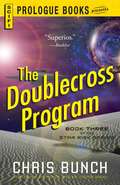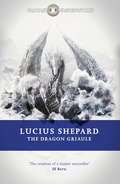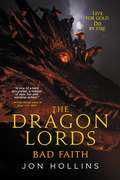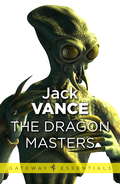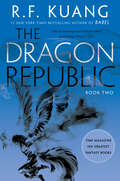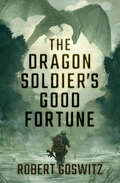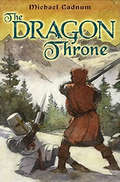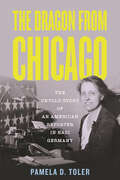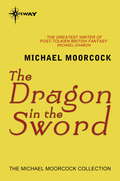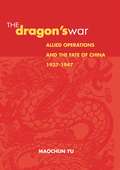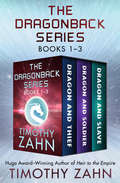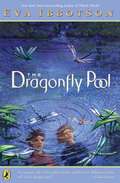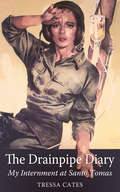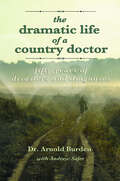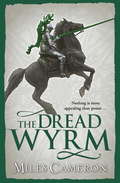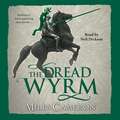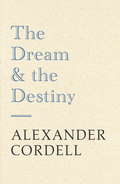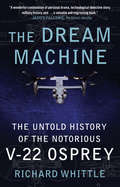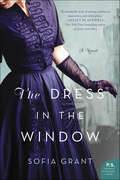- Table View
- List View
The Doublecross Program: Book Three of the Star Risk Series
by Chris BunchM’chel Riss and the Star Risk team are enjoying a little well-deserved R&R . . . until funds get a bit low. Then it’s time to swing back into action. The next thing they know, they’re in the middle of the weirdest gig they’ve had yet: a staged bank robbery that involves putting the money back. Oh, yes - and a full-fledged war over a new addictive consumer product. Things are always interesting in the high-flying world of corporate intrigue and espionage. Just the place for the Star Risk, Ltd., team.
The Dragon Griaule (FANTASY MASTERWORKS)
by Lucius ShepardLucius Shepard's acclaimed Dragon Griaule stories are presented here for the first time in a single volume. This Fantasy Masterworks edition contains:'The Man Who Painted the Dragon Griaule''The Scalehunter's Beautiful Daughter''The Father of Stones''Liar's House''The Taborin Scale''The Skull'This is the definitive tail of the Dragon Griaule: a beast so immense its body forms part of the landscape ...
The Dragon Lords: Bad Faith (The Dragon Lords)
by Jon HollinsGuardians of the Galaxy meets the Hobbit in this rollicking fantasy adventure. Will and his comrades went to war to overthrow the reign of dragons, winning battle after battle, and acclaim as conquering heroes. But now they've angered the gods, and may just need the dragons to help them this time..."Jon Hollins is a one-of-a-kind storyteller, a master of epic fun and nonstop action." - Nicholas Eames, author of Kings of the WyldThe Dragon Lords The Dragon Lords: Fool's GoldThe Dragon Lords: False IdolsThe Dragon Lords: Bad Faith
The Dragon Masters and Other Stories (Gateway Essentials #203)
by Jack VanceThe race of man is growing old, but it's not yet ready to die - not while there are dragons still to kill! The cross-bred dragon armies of the Men of Aerlith are the most appalling horrors ever to threaten the sanity of our future:Termagents ~ three hundred reptilian giants with six legs apiece, the most fecund breeders of them all. Jugglers ~ eighteen of them, growling amongst themselves, waiting for an opportunity to snap off a leg from any unwary groom. Murderers (striding and long-horned) ~ eighty-five of each, with scaly tails and eyes like crystals. Fiends ~ fifty-two powerful monsters, their tails tipped with spike steel balls. Blue Horrors, Basics, Spider Dragons... the enemy has no chance.
The Dragon Republic (The Poppy War #2)
by R. F KuangRin’s story continues in this acclaimed sequel to The Poppy War—an epic fantasy combining the history of twentieth-century China with a gripping world of gods and monsters.The war is over.The war has just begun.Three times throughout its history, Nikan has fought for its survival in the bloody Poppy Wars. Though the third battle has just ended, shaman and warrior Rin cannot forget the atrocity she committed to save her people. Now she is on the run from her guilt, the opium addiction that holds her like a vice, and the murderous commands of the fiery Phoenix—the vengeful god who has blessed Rin with her fearsome power. Though she does not want to live, she refuses to die until she avenges the traitorous Empress who betrayed Rin’s homeland to its enemies. Her only hope is to join forces with the powerful Dragon Warlord, who plots to conquer Nikan, unseat the Empress, and create a new republic. But neither the Empress nor the Dragon Warlord are what they seem. The more Rin witnesses, the more she fears her love for Nikan will force her to use the Phoenix’s deadly power once more. Because there is nothing Rin won’t sacrifice to save her country . . . and exact her vengeance.
The Dragon Soldier's Good Fortune
by Robert GoswitzAn American soldier in Vietnam is guided through the war by a supernatural spirit in Robert Goswitz&’s The Dragon Soldier&’s Good Fortune. Pvt. Ed Lansky is a fresh recruit in Vietnam, trying to navigate his way through the war-torn region. It will take more than basic training to survive dangerous missions through the oppressive heat of the jungles against the tactics of an unpredictable enemy. From Sergeant Chen, whose arms are covered in dragon tattoos, Lansky learns how the Dragon Spirit protected the Vietnamese from evil specters in ancient times. Skeptical of Chen&’s true belief in the country&’s Dragon power, Lansky chooses to place his faith in the recreational drugs circulating among the troops to cope with his tour of duty. But in time he learns that there is something greater watching over him, keeping him safe from the horrors of war and healing his pain. A large, green dragon has seemingly bonded with Lansky, making him realize that this Vietnamese Spirit is no myth, and embraces his protector. Pvt. Vernon Huddle is suspicious of Lansky&’s continued, unscathed survival in battle after battle. As Lansky receives medals and media recognition for his heroics, Huddle believes his uncanny success portends an approaching apocalypse that may consume their very souls. And as the war worsens for last remaining American infantry in Vietnam, Lansky wonders why the country&’s Dragon Spirit chose him—and if its power will see him safely home . . .
The Dragon Throne
by Michael CadnumEdmund and Herbert, newly made knights, return to England expecting to revel in the pleasure of being home. Instead, scheming Prince John has a new task for the weary Crusaders; they are to escort two young women on a pilgrimage to Rome, a journey that will take them through the perilous Alps, controlled by bands of brigands. And once in Rome, even greater hazards await. Suspenseful, exciting, and filled with colorful details of 12th century Europe, this final volume of the trilogy that began with The Book of the Lion will thrill readers.
The Dragon Throne
by Michael CadnumEdmund and Herbert, newly made knights, return to England expecting to revel in the pleasure of being home. Instead, scheming Prince John has a new task for the weary Crusaders; they are to escort two young women on a pilgrimage to Rome, a journey that will take them through the perilous Alps, controlled by bands of brigands. And once in Rome, even greater hazards await. Suspenseful, exciting, and filled with colorful details of 12th century Europe, this final volume of the trilogy that began with The Book of the Lion will thrill readers.
The Dragon from Chicago: The Untold Story of an American Reporter in Nazi Germany
by Pamela D. TolerFor fans of unheralded women&’s stories, a captivating look at Sigrid Schultz—one of the earliest reporters to warn Americans of the rising threat of the Nazi regime &“No other American correspondent in Berlin knew so much of what was going on behind the scene as did Sigrid Schultz.&” — William L. Shirer, author of The Rise and Fall of the Third ReichWe are facing an alarming upsurge in the spread of misinformation and attempts by powerful figures to discredit facts so they can seize control of narratives. These are threats American journalist Sigrid Schultz knew all too well. The Chicago Tribune's Berlin bureau chief and primary foreign correspondent for Central Europe from 1925 to January 1941, Schultz witnessed Hitler&’s rise to power and was one of the first reporters—male or female—to warn American readers of the growing dangers of Nazism.In The Dragon From Chicago, Pamela D. Toler draws on extensive archival research to unearth the largely forgotten story of Schultz&’s years spent courageously reporting the news from Berlin, from the revolts of 1919 through the Nazi rise to power and Allied air raids over Berlin in 1941. At a time when women reporters rarely wrote front-page stories and her male colleagues saw a powerful unmarried woman as a &“freak,&” Schultz pulled back the curtain on how the Nazis misreported the news to their own people, and how they attempted to control the foreign press through bribery and threats.Sharp and enlightening, Schultz's story provides a powerful example for how we can reclaim truth in an era marked by the spread of disinformation and claims of &“fake news.&”
The Dragon in the Sword
by Michael MoorcockThe third book of The Eternal Champion trilogy.John Daker is the Eternal Champion, trapped in a dimensionless plane outside of time, defender and destroyer of justice, a hero whose quest for justice leads only further into darkness. Haunted by the memories of too many battles waged during countless lifetimes, he searches for the beautiful Ermizhad - and for the key that will allow him to step off the wheel of infinite incarnations. His is a voyage on a dark ship piloted by a blind helmsman, through the slave stalls of the Cannibal Ghost Women and the tunnels of doom to a monstrous confrontation with the Evil that could plunge the world into the final night of oblivion.
The Dragon's War
by Maochun YuMaking full use of significant new sources in Chinese-language materials, U.S. Naval Academy professor Maochun Yu provides Western readers with the first detailed account of military and intelligence operations conducted inside China by foreign powers between 1937 and 1945. He also addresses the profound impact of these operations upon China's nationalism, wartime politics, and overall military campaigns. Arguing that operations by the USSR, the United States, Britain, and France, in particular, challenged the authority and legitimacy of the Chinese nationalist government, he illustrates how the failure of the Nationalist Government under Chiang Kai-shek to control these operations contributed to its demise following World War II. This provocative work unveils like never before the extraordinary intrigue, command and operational manipulations, international espionage, and politics surrounding military and intelligence operations in wartime China among the allies. It covers such topics as foreign military aid programs to China; the Chinese secret police's massive joint intelligence organization with the U.S. Navy; special intelligence initiatives conducted by the British, Free French, and Americans; secret British and American dealings with the Chinese Communists; America's first covert overseas military operation (the Flying Tigers); and Soviet and American military personnel in the China theater. The author points to the remarkable political and military ramifications that these operations had in China, including the inadvertent creation of conditions that allowed the rise of Communist China. With its implications on the world scene today, such an important new perspective of China during its war against Japan will appeal to a general audience as well as to students of World War II and specialists in the military and intelligence communities.
The Dragonback Series Books 1–3: Dragon and Thief, Dragon and Soldier, and Dragon and Slave (The Dragonback Series)
by Timothy ZahnThe first three adventures in the Dragonback science fiction fantasy series from the #1 New York Times–bestselling author of the Thrawn series. Dragon and Thief: Young thief and con artist Jack Morgan is hiding out on an uninhabited planet after he&’s falsely accused of a crime. But his solitude is interrupted when Draycos, a warrior whose reptilian race is being targeted for extinction, makes an emergency landing. The two will be able to survive, but only if they literally bond together . . . Dragon and Soldier: When all is well, Draycos looks like nothing more than a tattoo on Jack Morgan&’s back. But when Jack&’s threatened, the K&’da warrior appears in his true, dragonlike form. Together they go undercover to investigate a mercenary outfit connected to the extermination of Draycos&’s people, and it turns out Jack isn&’t the only new recruit with a secret . . . Dragon and Slave: Following a lead, Jack becomes a slave on a Brummga alien estate where he must find out all he can while under the cruel watch of a vicious slave master who has no problem killing the help. Fortunately, Draycos always has his back.
The Dragonfly Pool
by Eva IbbotsonAt first Tally doesn't want to go to the boarding school called Delderton. But soon she discovers that it's a wonderful place, where freedom and self-expression are valued.
The Drainpipe Diary: My Internment at Santo Tomas
by Tressa R. CatesThe Drainpipe Diary, first published in 1957, is the moving account by an American nurse of her internment at Santo Tomas in Manila during World War II. She began her detailed diary on January 5, 1942, the date she was to have married her fiancé, but which instead marked the beginning of three long years of internment in the Santo Tomas Camp. As the war turned against the Japanese, conditions in the camp steadily worsened, food and medical supplies became inadequate, and deaths among the internees increased. The author's diary recounts day-to-day life and concerns in the camp, with Cates determined to document her experience despite the dangers it posed if discovered. The diary continues until liberation of the camp by American troops in February 1945, and ends on June 24, 1945, when she and her fiancée finally wed before returning to the United States. Tressa Cates passed away in 1991.
The Dramatic Life of a Country Doctor: Fifty Years of Disasters and Diagnoses
by Arnold Burden Andrew SaferA Canadian physician reflects on a lifetime of helping others, including during World War II and two deadly mining disasters.Dr. Arnold Burden&’s career began unintentionally when he performed his first surgery in the woods following a hunting accident at age fourteen. As a twenty-year-old hospital clerk, he handed battle casualties after D-Day in France and Germany. His early years as a doctor began in rural Prince Edward Island, where he served in the combined role of doctor and coroner. Back home in Springhill, Nova Scotia, Dr. Burden was the first medic to enter the mines after the deadly No. 4 mine explosion in 1956 and the No. 2 mine bump, the most severe bump ever recorded in North America, in 1958. In both cases he risked his life alongside the underground rescue teams to bring the gassed and trapped miners to the surface. In this new edition Dr. Burden gives his account of an active life and of a man dedicated to his patients; a man full of common-sense and interesting stories, who writes candidly of his dealing with patients, unusual cases, and brave efforts made under difficult conditions. As the author states: &“The real satisfaction in life has come from helping people.&”
The Dramatic Life of a Country Doctor: Fifty Years of Disasters and Diagnoses
by Arnold Burden Andrew SaferA Canadian physician reflects on a lifetime of helping others, including during World War II and two deadly mining disasters.Dr. Arnold Burden&’s career began unintentionally when he performed his first surgery in the woods following a hunting accident at age fourteen. As a twenty-year-old hospital clerk, he handed battle casualties after D-Day in France and Germany. His early years as a doctor began in rural Prince Edward Island, where he served in the combined role of doctor and coroner. Back home in Springhill, Nova Scotia, Dr. Burden was the first medic to enter the mines after the deadly No. 4 mine explosion in 1956 and the No. 2 mine bump, the most severe bump ever recorded in North America, in 1958. In both cases he risked his life alongside the underground rescue teams to bring the gassed and trapped miners to the surface. In this new edition Dr. Burden gives his account of an active life and of a man dedicated to his patients; a man full of common-sense and interesting stories, who writes candidly of his dealing with patients, unusual cases, and brave efforts made under difficult conditions. As the author states: &“The real satisfaction in life has come from helping people.&”
The Dread Wyrm
by Miles CameronSOME ARE BORN TO POWERSOME SEIZE ITAND SOME HAVE THE WISDOM NEVER TO WIELD ITThe Red Knight has stood against soldiers, against armies and against the might of an empire without flinching. He's fought on real and on magical battlefields alike, and now he's facing one of the greatest challenges yet. A tournament.A joyous spring event, the flower of the nobility will present arms and ride against each other for royal favour and acclaim. It's a political contest - and one which the Red Knight has the skill to win. But the stakes may be higher than he thinks. The court of Alba has been infiltrated by a dangerous faction of warlike knights, led by the greatest knight in the world: Jean de Vrailly - and the prize he's fighting for isn't royal favour, but the throne of Alba itself.Where there is competition there is opportunity; the question is, will the Red Knight take it? Or will the creatures of the Wild seize their chance instead . . .
The Dread Wyrm
by Miles CameronSOME ARE BORN TO POWERSOME SEIZE ITAND SOME HAVE THE WISDOM NEVER TO WIELD ITThe Red Knight has stood against soldiers, against armies and against the might of an empire without flinching. He's fought on real and on magical battlefields alike, and now he's facing one of the greatest challenges yet. A tournament.A joyous spring event, the flower of the nobility will present arms and ride against each other for royal favour and acclaim. It's a political contest - and one which the Red Knight has the skill to win. But the stakes may be higher than he thinks. The court of Alba has been infiltrated by a dangerous faction of warlike knights, led by the greatest knight in the world: Jean de Vrailly - and the prize he's fighting for isn't royal favour, but the throne of Alba itself.Where there is competition there is opportunity; the question is, will the Red Knight take it? Or will the creatures of the Wild seize their chance instead . . . 'A stirring, gritty and at times quite brutal epic fantasy' Tor.com'This series promises to be the standout epic fantasy for the ages' Fantasy Book CriticRead by Neil Dickson(p) 2015 Hachette Audio
The Dream And The Destiny
by Alexander CordellThe Long March was an extraordinary feat of human endurance. Lin-Wai, a young doctor newly recruited into the Red Army, is caught up in the breakout of the followersof Mao and their ensuing flight. The marchers struggle on through pain and suffering, under continual harrassment from the enormously superior Kuomintang forces. Through the blistering heat of the Grasslands to the icy-zub-zero temperatures of the Great Snow Mountain, they march. Over a hundred thousand men begin the march. Only five thousand will survive.
The Dream Machine
by Richard WhittleWHEN THE MARINES decided to buy a helicopter-airplane hybrid "tiltrotor" called the V-22 Osprey, they saw it as their dream machine. The tiltrotor was the aviation equivalent of finding the Northwest Passage: an aircraft able to take off, land, and hover with the agility of a helicopter yet fly as fast and as far as an airplane. Many predicted it would reshape civilian aviation. The Marines saw it as key to their very survival. By 2000, the Osprey was nine years late and billions over budget, bedeviled by technological hurdles, business rivalries, and an epic political battle over whether to build it at all. Opponents called it one of the worst boondoggles in Pentagon history. The Marines were eager to put it into service anyway. Then two crashes killed twenty- three Marines. They still refused to abandon the Osprey, even after the Corps' own proud reputation was tarnished by a national scandal over accusations that a commander had ordered subordinates to lie about the aircraft's problems. Based on in-depth research and hundreds of interviews, The Dream Machine recounts the Marines' quarter-century struggle to get the Osprey into combat. Whittle takes the reader from the halls of the Pentagon and Congress to the war zone of Iraq, from the engineer's drafting table to the cockpits of the civilian and Marine pilots who risked their lives flying the Osprey--and sometimes lost them. He reveals the methods, motives, and obsessions of those who designed, sold, bought, flew, and fought for the tiltrotor. These stories, including never before published eyewitness accounts of the crashes that made the Osprey notorious, not only chronicle an extraordinary chapter in Marine Corps history, but also provide a fascinating look at a machine that could still revolutionize air travel.
The Dreaming Suburb (The Avenue #1)
by R. F. DelderfieldBetween the wars, the lives of four neighboring English families intersect in this &“highly recommended&” saga by a New York Times–bestselling author (Sunday Express). In the spring of 1919, his wife&’s death brings Sergeant Jim Carver home from the front. He returns to be a single parent to his seven children in a place he has never lived: Number Twenty, Manor Park Avenue, in a South London suburb. The Carvers&’ neighbor Eunice Fraser, at Number Twenty-Two, has also known tragedy. Her soldier husband was killed, leaving her and her eight-year-old son, Esme, to fend for themselves. At Number Four, Edith Clegg takes in lodgers and looks after her sister, Becky, whose mind has been shattered by a past trauma. No one knows much about the Friths, at Number Seventeen, who moved to the Avenue before the war. The first book in the two-part historical series the Avenue, which also includes The Avenue Goes to War, The Dreaming Suburb takes readers into the everyday lives of these English families between World War I and World War II, as their hopes, dreams, and struggles are played out against a radically changing world.
The Dress Thief: one secret could destroy everything she holds dear...
by Natalie Meg EvansAlix Gower may be poor but she's also ambitious, and she'd do anything to secure her dream job in one of Paris's premier fashion houses. But Alix also has a secret: she supports her family by stealing from the very houses she so adores. But can Alix risk her reputation and her relationships forever? And is the handsome English reporter she keeps bumping into really to be trusted? 'Wonderful! I didn't want to put this book down' Amazon reviewer. Perfect for fans of The Keeper of Lost Things, Island of Secrets and Amy Snow.
The Dress in the Window: A Novel
by Sofia GrantA perfect debut novel is like a perfect dress—it’s a “must have” and when you “try it on” it fits perfectly. In this richly patterned story of sisterhood, ambition, and reinvention Sofia Grant has created a story just right for fans of Vintage and The Dress Shop of Dreams.World War II has ended and American women are shedding their old clothes for the gorgeous new styles. Voluminous layers of taffeta and tulle, wasp waists, and beautiful color—all so welcome after years of sensible styles and strict rationing. Jeanne Brink and her sister Peggy both had to weather every tragedy the war had to offer—Peggy now a widowed mother, Jeanne without the fiancé she’d counted on, both living with Peggy’s mother-in-law in a grim mill town. But despite their grey pasts they long for a bright future—Jeanne by creating stunning dresses for her clients with the help of her sister Peggy’s brilliant sketches. Together, they combine forces to create amazing fashions and a more prosperous life than they’d ever dreamed of before the war. But sisterly love can sometimes turn into sibling jealousy. Always playing second fiddle to her sister, Peggy yearns to make her own mark. But as they soon discover, the future is never without its surprises, ones that have the potential to make—or break—their dreams.
The Dressing Station: A Surgeon's Chronicle of War and Medicine
by Jonathan KaplanIn this &“vividly compelling&” New York Times Notable Book, a surgeon recounts his experiences in war zones (The Washington Post). From treating the casualties of apartheid in Cape Town to operating on Kurdish guerrillas in Northern Iraq at the end of the Gulf War, Jonathan Kaplan has saved (and lost) lives in the remotest corners of the world in the most extreme conditions. He has been a hospital surgeon, a ship&’s physician, an air-ambulance doctor, and a trauma surgeon. He has worked in locations as diverse as England, Burma, Eritrea, the Amazon, Mozambique, and the United States. In his &“eloquent . . . beautifully written&” memoir of unforgettable adventure and tragedy, Dr. Kaplan explores the great challenge of his career—to maintain his humanity in the face of incredible pain and suffering (The New York Times Book Review). &“Packed with moments of searing intensity,&” The Dressing Station is an &“extraordinary&” look into the nature of human violence, the shattering contradictions of war, and the complicated role of medicine in the modern world (The Washington Post). &“In this refreshingly unsentimental memoir, [Kaplan] offers a vivid look at what it&’s like to practice medicine in places where there are always too many casualties and not enough resources. His descriptions of surgery are unflinching . . . Kaplan gives us a remarkable self-portrait of the war junkie.&” —The New Yorker
The Dressmaker of Paris: 'A story of loss and escape, redemption and forgiveness. Fans of Lucinda Riley will adore it' (Sunday Express)
by Georgia Kaufmann'Involving, immersive and unputdownable' - bestselling author Jill MansellI need to tell you a story, ma chère. My story.Rosa Kusstatscher has built a global fashion empire upon her ability to find the perfect outfit for any occasion. But tonight, as she prepares for the most important meeting of her life, her usual certainty eludes her.What brought her to this moment? As she struggles to select her dress and choose the right shade of lipstick, Rosa begins to tell her incredible story. The story of a poor country girl from a village high in the mountains of Italy. Of Nazi occupation and fleeing in the night. Of hope and heartbreak in Switzerland; glamour and love in Paris. Of ambition and devastation in Rio de Janeiro; success and self-discovery in New York.A life spent running, she sees now. But she will run no longer.Breathtaking and utterly enthralling, The Dressmaker of Paris is perfect for fans of Lucinda Riley, Kate Morton and Dinah Jefferies.'The Dressmaker of Paris is a delicious book: elegantly structured, beautifully written and with a fascinating protagonist. Georgia Kaufmann has created a beautiful and compelling novel that had me hooked until the very last page. And that ending: wow!' - Gill Thompson, bestselling author of The Oceans Between Us'Sensuous, sweeping and utterly engrossing, The Dressmaker of Paris is as dazzling and finely crafted as a Dior gown' - Rachel Rhys, bestselling author of Dangerous Crossing'The story of a remarkable woman . . . A book you will lose yourself in' - Gill Paul, bestselling author of THE LOST DAUGHTER
